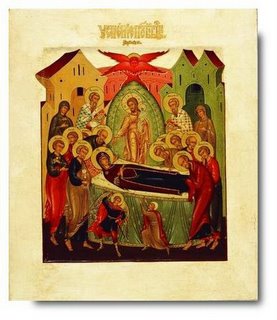 and countless other examples, even in England, though it is normally associated with the east.
and countless other examples, even in England, though it is normally associated with the east.The Murrillo is very definitely taken from the book of the Apocalypse, the woman clothed (rather weakly with the sun) standing on the moon is taken up into heaven, she seems to go up under her own steam which isn't quite what the dogma actually says; she was "taken up" into heaven.
The icon however is actually Mary's funeral, she falls asleep the Church gathers around her, it is not the Church of any particular period, the Apostles Peter and Paul are there with the other Apostles but there are also later Fathers of the Church and the holy women too; Christ himself is there and takes her soul, all happens in the presence of the heavenly cout signified by the seraph. In many ways it could be an icon of any funeral; when we die Christ will come and take our soul to himself, the Holy Apostles and all the other saints of the Church will surround out deathbed. However there is something different here, in the foreground there is a angel who with a sword cuts off the hands of a sinner who is trying to take relics of the Theotokos. What amazed the ancients was that there were no corporal relics of Mary, according to the Easter tradition Mary died at Ephesus or Jerusalem and was buried, days later the Apostles went to the tomb and it was found to be empty. Thus "the Immaculate virgin Mary was assumed body and soul into heaven" click here to read the document that formally defined this dogma.
This Dogma of the faith is rich in meaning, the scripture readings of the day remind us of the struggle between the reign of God and the reign of sin. The women clothed in the sun (an image typically found in England in the middle ages and the image of O.L. of Guadalupe) is taken up into Heaven, in the Apocalypse she is unidentified and can be seen as Our Lady, as humanity, as Israel, as the Church or all of these, for all give birth to the Son and all are by his Cross taken up into heaven and glorified.
 The ancient Fathers of the Church identified Mary with Ark of the Covenant which mysteriously disappeared, some rabbis teaching it was taken up into heaven.
The ancient Fathers of the Church identified Mary with Ark of the Covenant which mysteriously disappeared, some rabbis teaching it was taken up into heaven.She is also identified with "the bush that burnt and yet was not consumed" at which Moses met the Lord who revealed his name, this is not to far away from the image the "woman clothed with the sun" or the "Queen clothed in gold of Ophyr".
19th cent Russian icon taken from Temple Gallery catalogue click it to see the catalogue



No comments:
Post a Comment